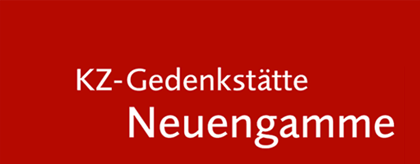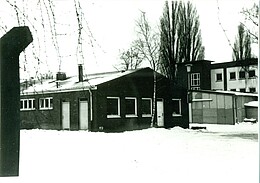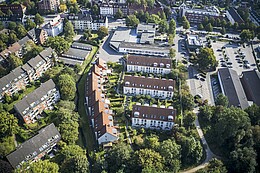Hamburg-Wandsbek
In June 1944, a transport from Ravensbrück concentration camp brought nearly 500 women to Hamburg-Wandsbek for forced labour. The camp was under the authority of the Ravensbrück concentration camp until 31 August 1944. In the course of an administrative rearrangement, it became part of the Neuengamme camp system on 1 September 1944.
Another smaller group of women arrived at the end of September. In the spring of 1944, three huts had been set up to house the prisoners at Ahrensburger Straße 162, in the grounds of the Hamburg branch of Drägerwerk AG from Lübeck. Most of the women here came from Poland or the Soviet Union, though there were also women from Slovenia, France, Belgium, the Netherlands, Germany and Czechoslovakia among them. They were forced to make gas masks for the so-called Brandt device programme of Drägerwerk in Hamburg, and in the last weeks of the war they also carried out clearance work in Hamburg following bomb attacks. In March 1945, Drägerwerk carried out experiments to determine how long someone could survive in a gas-proof air-raid shelter without a ventilation system. Prisoners from the Wandsbek satellite camp were taken to air-raid shelters throughout Hamburg for these experiments.
In April 1945, another transport of women from the Helmstedt-Beendorf satellite camp reached Hamburg-Wandsbek. Some of these women were taken to the Hamburg-Eidelstedt satellite camp shortly before the end of the war, where they were liberated by the British army on 5 May 1945. Most of the women from the Wandsbek camp were rescued by the Swedish Red Cross, who took them by train from Hamburg to Padborg in Denmark on 1 May 1945, and from there to Sweden.
The Hamburg-Wandsbek satellite camp for women was commanded by SS-Unterscharführer Johannes Heinrich Steenbock, temporarily by SS-Untersturmführer Max Kierstein, and later by Friedrich Wilhelm Hinz, who was posted to concentration camp duties by the Wehrmacht.
Period
8 June 1944 to 30 April 1945
Number of Prisoners
550 Female Prisoners
Kind of Work
Production of gas masks (for the Brandt device programme)
Labor on Behalf of
Drägerwerk AG Lübeck
Location
Directions
Ahrensburger Straße 162
22045 Hamburg
Germany
Directions by public transportation: From the Rahlstedt urban rail station (S-Bahn) or Wandsbek-Markt underground station (U-Bahn), take bus number 9 to the “Tonndorf” stop (Nordmarkstraße).
Memorial
In May 1988, a plaque was installed at the entrance to the grounds of Agfa-Gevaert, the site of the former satellite camp, by the Hamburg Cultural Authority as part of its "Sites of Persecution and Resistance 1933-1945" programme (Stätten der Verfolgung und des Widerstandes 1933–1945). It was placed there at the initiative of students of Hamburg University and the Wandsbek Anti-Fascist Initiative (Antifaschistischen Initiative Wandsbek). The text for the plaque was the subject of debate because Drägerwerk wanted no mention of the abuse of the prisoners, the type of work they were forced to carry out, or how they were housed.
When the grounds ceased to be used for industrial purposes, a housing estate named "An der Rahlau" was built in 2004/2005. The property developer was obliged by the Wandsbek district office to create a small memorial on the site, but only a few fence posts and historical wash basin were placed to commemorate the former camp, and there was no signage. The small memorial was redesigned in 2007 following public criticism, but public access to the site remains a matter of debate.
In 2010, a second, larger memorial with an abstract sculpture opened next to the site of the former camp. This memorial is publicly accessible. The sculpture is composed of equilateral triangles which reference the triangles that the SS forced concentration camp prisoners to wear on their clothing for identification. Six granite triangles are inscribed with the names of the women who were imprisoned in the Drägerwerk satellite camp. The main sculpture consists of two interlocked triangles wrapped in chains. It was designed by students taking an art course at the Charlotte Paulsen Secondary School.


